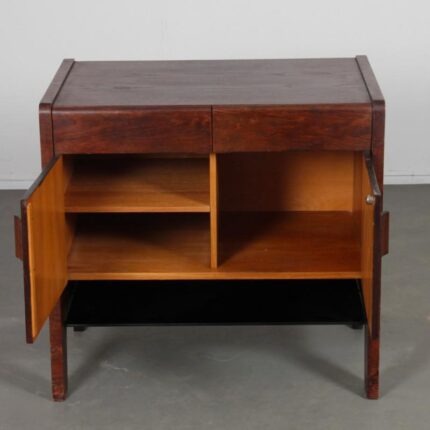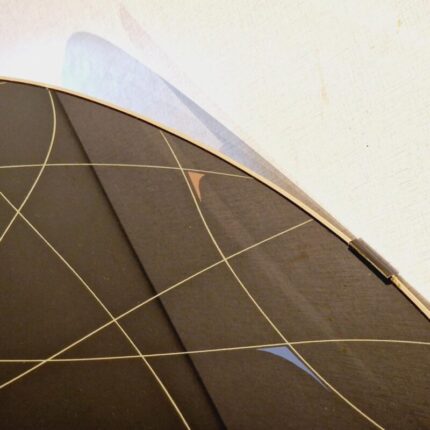They are made of dark or almost black stained beech wood in mahogany tone and French polished, a technique that involves hand applying many thin coats of shellac which was used for high quality pieces in that time.
The seats and backs are upholstered in a green or turquoise leather. Nice brass screws and nails are in contrast to the dark wood and green leather.
The chairs are in very good condition and have been restored about 10 years ago.
There is also a matching seette or bench available. The whole set is offered in separate listing.
About Marcel Kammerer:
Marcel Kammerer (born 11/4/1878 in Vienna, died 12/25/1959 in Montreal) was an Austrian architect and painter. He was pupil of Otto Wagner and worked several years as chef designer for his studio were he worked for many important projects like the ‘Kirche am Steinhof’. Marcel Kammerer designed most of the furniture for the ‘Postsparcassen-Amt’ which was one of the most important projects from Otto Wagner.
Later Marcel Kammerer establishd his own studio.
His work also was influenced by Josef Hoffmann which was one of the most important Austrian architects.
Between the world wars Marcel Kammerer primary worked was as painter. After 1945 he emigrated to Canada.
Otto Wagner was born in Penzing, a district in Vienna. He was the son of Suzanne (née von Helffenstorffer-Hueber) and Rudolf Simeon Wagner, a notary to the Royal Hungarian Court. He studied architecture at the Viennese Polytechnic Institute and the Royal School of Architecture in Berlin. After completing his education, he returned to Vienna to work. In 1864, he started designing his first buildings in the historicist style. In the mid- and late 1880s, like many of his contemporaries in Germany (such as Constantin Lipsius, Richard Streiter and Georg Heuser), Switzerland (Hans Auer and Alfred Friedrich Bluntschli) and France (Paul Sédille), Wagner became a proponent of Architectural Realism. It was a theoretical position that enabled him to mitigate the reliance on historical forms. In 1894, when he became Professor of Architecture at the Academy of Fine Arts Vienna, he was well advanced on his path toward a more radical opposition to the prevailing currents of historicist architecture.
By mid-1890s, he had already designed several Jugendstil buildings. Wagner was very interested in urban planning — in 1890 he designed a new city plan for Vienna, but only his urban rail network, the Stadtbahn, was
built. In 1896 he published a textbook entitled Modern Architecture in which he expressed his ideas about the role of the architect; it was based on the text of his 1894 inaugural lecture to the Academy. His style incorporated the use of new materials and new forms to reflect the fact that society itself was changing. In his textbook, he stated that “new human tasks and views called for a change or reconstitution of existing forms”. In pursuit of this ideal, he designed and built structures that reflected their intended function, such as the austere Neustiftgasse apartment block in Vienna.
In 1897, he joined Gustav Klimt, Joseph Maria Olbrich, Josef Hoffmann and Koloman Moser shortly after they founded the “Vienna Secession” artistic group. From the ideas of this group he developed a style that included quasi-symbolic references to the new forms of modernity.
The Vienna Secession’s work is often referred to (during the years before World War I) as the Austrian version of Jugendstil, the German term for Art Nouveau.
Wagner had a strong influence on his pupils at the Academy of Fine Arts in Vienna. This “Wagner School” included Josef Hoffmann, Joseph Maria Olbrich, Karl Ehn, Jože Plecnik and Max Fabiani. Another student of Wagner’s was Rudolph Schindler, who said “Modern Architecture began with Mackintosh in Scotland, Otto Wagner in Vienna, and Louis Sullivan in Chicago.” Wagner died in Vienna in 1918.
-
Creator:Marcel Kammerer(Designer),Thonet(Maker)
-
Dimensions:Height: 30.71 in (78 cm)Width: 22.05 in (56 cm)Depth: 23.63 in (60 cm)Seat Height: 18.9 in (48 cm)
-
Sold As:Set of 2
-
Style:Jugendstil(Of the Period)
-
Materials and Techniques:BeechBentwoodLeatherStained
-
Place of Origin:Austria
-
Period:1900-1909
-
Date of Manufacture:1910
-
Condition:GoodRefinished. Reupholstered. Wear consistent with age and use. The chairs are in very good condition and have been restored about 10 years ago.
-
Seller Location:Hausmannstätten, AT
-
Reference Number:Seller: LU1082414596851


























































Reviews
There are no reviews yet.